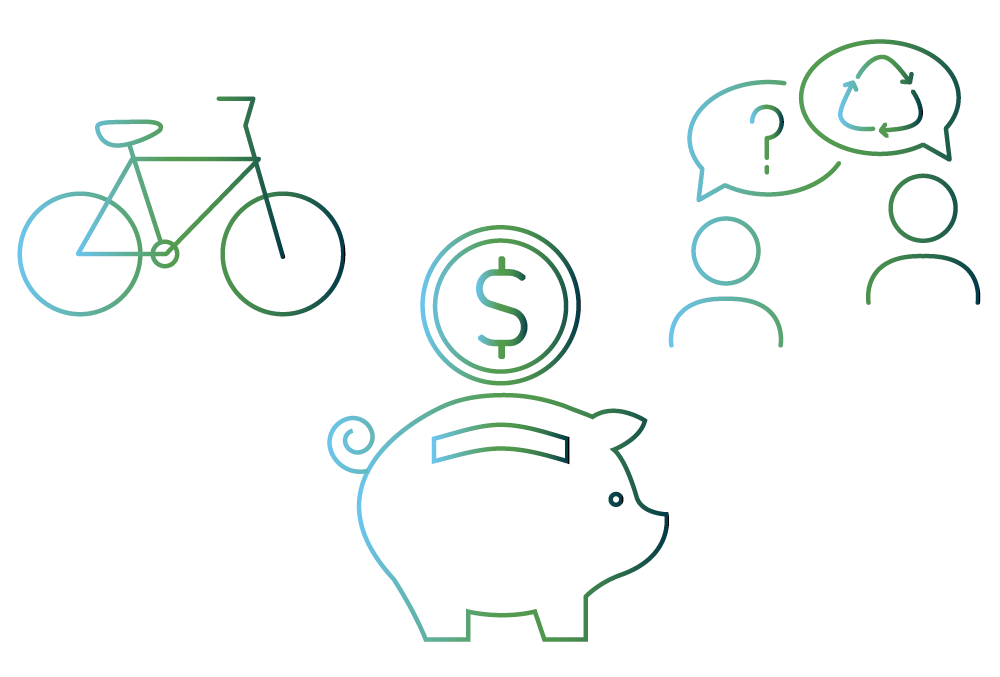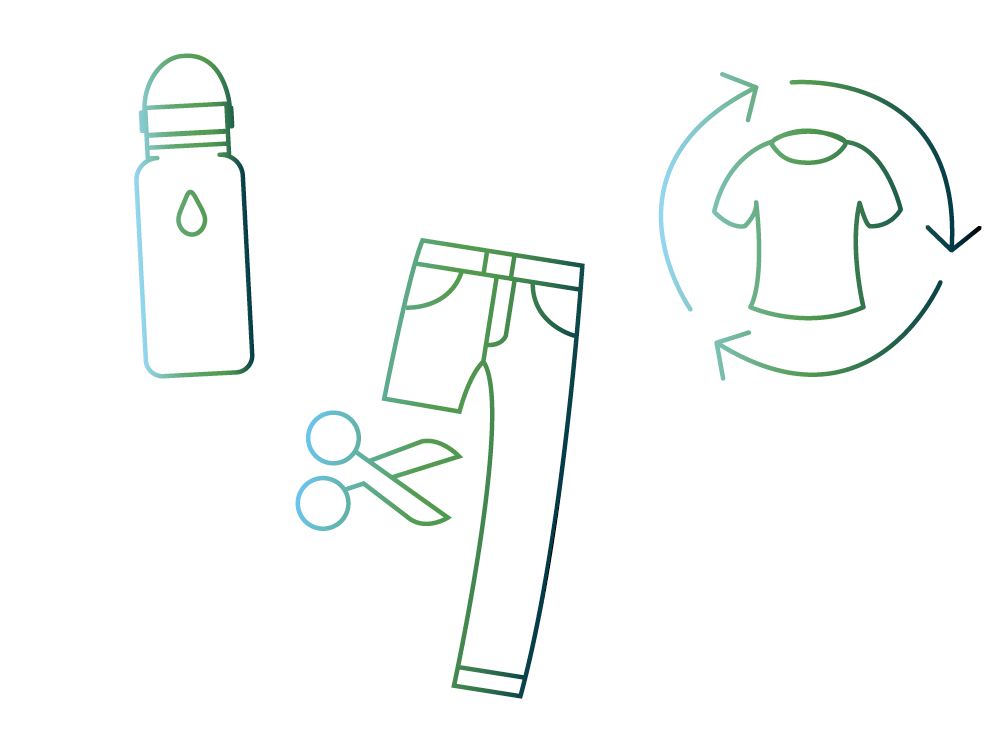
In today’s climate it’s important to know how to not only better ourselves but the space in which we inhabit as well. Alexa Reyes, Marinelle Manansala and Steve Tomori interview Miranda Gorman about the ideas of sustainability, implementation and consumption. We discuss ways in which these topics affect us and how we can challenge how we are related to them. She provides us ways in which we can see these ideas implemented in our everyday life such as reducing our carbon footprint, having conversations with ourselves and those around us and thinking about the life cycle of objects we encounter. Miranda Gorman’s research focuses on the sustainability of material resources. She completed her Ph.D. in 2019 in the Environmental Engineering, Sustainability and Science Group at Carnegie Mellon University.
Miranda Gorman: When I first started my Ph.D. program, I wanted to learn about lots of different systems—and environmental impact on a very large scale. The field that led me into this was life-cycle assessments, where you think about a system or program or a good throughout its entire lifecycle, and try to analyze all of the environmental impacts through each lifecycle phase, from extraction through processing. Material resources was another thing that was interesting to me, because I think it’s an area that gets overlooked a lot. When people are thinking about sustainability, they aren’t thinking about the fact that literally everything that we own is made out of something and most of the time, that stuff is not renewable.

MG: I think that there is a possibility. There’s something that we talk about a lot in environmental engineering, which is called the rebound effect: when you see an improvement in something, the immediate reaction is a negative effect. I would not be that shocked if there were some sort of a rebound effect after this, where everyone starts taking a million flights and goes on vacation. Because honestly, I would kill for a vacation.
I do think that there is an opportunity here to learn, and I think that people are realizing now what is and isn’t necessary in the choices that they make. There is an opportunity for a long-term, net reduction in individuals’ transportation and greenhouse gas footprints. However the majority of greenhouse gas emissions are not from individual choices. It’s not from people commuting to work and stuff like that. After a short-term rebound effect, if those do fall to a slightly lower level, I think that there’s an opportunity for industry to start thinking about how they can promote changes within themselves and not just count on individuals making choices. Making sustainable choices can be a smart business decision.

MG: That’s definitely a tough question. There’s obviously a major component, which are the everyday changes that we can make in our own personal lives and in your circle. Beyond being a research organization—Drawdown is a communications organization. A really big goal of the production of all of our scientific and analytical studies is communicating those results to the public and making it clear to individuals and to corporations what the potential and benefits of reversing climate change include.
One of the things that we do is investigate all the solutions that we model. We also identify the finances of adopting that solution. Maybe for this process, it’s going to be a little bit more expensive up front, the first costs are going to increase, but over the course of the lifetime of this system, there’s actually going to be net savings. That is actually typically what we see for sustainable choices. There’s energy savings associated with reduced energy costs. There’s a lot of ways in which making sustainable choices is actually a fiscally conservative decision. I think that advocating for that is one of the real advantages of the way that Drawdown does research and communicates our results. We say the equivalent cost associated with pollution, not only the total cost to clean up, trying to equivocate environmental impacts to a financial cost. You know it’s a capitalist society, and money is something that people understand.
MG: I think the Drawdown is a really great organization. The thing that drew me to it honestly is two things. The first is the ethos, which is basically that reversing climate change is possible. And really approaching this incredibly dire situation that we face every single day from an optimistic perspective. There’s science. Every single solution that we model exists today. And it’s scalable; these are solutions where all we have to do is make the choice. Nobody has to do any more research, nobody has to create some huge invention to fix everything. These are things that already exist and all people need to do is adopt them. And if you look at adopting them, it doesn’t even cost that much money. There’s a lot of opposition politically and unfortunately that’s something that is a major obstacle. We do live in a society where a lot of people don’t necessarily respect or listen to science. This is an everyday struggle that systemically needs to change before any of these traces can be made.
The other thing includes thinking about our entire system of solutions, because it is about how a hundred different technologies can contribute to solving one problem. When people are thinking about climate change, it’s all about renewable energy. People say, no more fossil fuels. And, that‘s important, and it matters. But I don’t really necessarily think that we should say everyone should stop drilling for oil. I don’t think that that makes sense because we need petroleum to make plastics for medical devices, for example. There are things in our lives that need to rely on some of these systems. Thinking about how the choices we make in materials and waste can contribute to climate change are really important. From the way that land is managed to choices you can make in buildings and transportation, all of these different areas could use a lot of promotion and are very valuable when done correctly.

MG: I do, actually, I think that there are choices that you can make specifically. Additionally, for low-income people. The things that are really important to think about in terms of lifecycle is extending the life of a good, preventing it from even entering the waste management stage. The end goal is keeping things in use, or if they reach end of life, figuring out a way to bring it back into the economy with minimal processing. The really easy solutions for those would be buying used goods, like thrift shopping. Additionally, figuring out a way to repair things. Instead of buying a new pair of jeans, which honestly costs more, if your jeans have ripped, figure out a way it can be repaired. Can you transition your ripped jeans into shorts? Is there something that you can do to extend the life cycle of a good?
The fashion industry has such a huge, huge carbon footprint, like, massive. And even though there’s so many choices now, and there are a lot of brands that are trying to make more sustainable choices, like Nike’s zero waste shoes. Those are all really phenomenal things.
MG: I think it’s probably different for me than for a lot of people honestly, because I live and breathe this. Transportation is a really big one. The cars that we drive, planes that we take, those types of things are probably the most significant contributors to carbon emissions. Making the choice to bike or walk or take public transportation is, I think, the easiest way to make more sustainable choices.
Something that I really tried to do is to reduce my material footprint. In no way am I perfect, I fully have a trash can, but I try to compost and to recycle. I try to make sure that I buy things that don’t have single-use plastics, and a really big one, for me, is trying not to shop and buy things that I don’t need, not only clothing, but anything like just consumption as a whole.
Trying to think about the lifecycle of the physical objects in our lives, where they come from and where they end up, is something that I think about when something is in front of me. It gives me pause... Do I need to purchase this item? Do I need to consume this good? How is it impacting its lifecycle?
MG: I think climate leadership is implementation. It’s making choices. It doesn’t really matter what the scale is, in my opinion. Climate leadership can be bringing your hydroflask to Starbucks. Or it can be Apple’s announcement last week about going carbon neutral by 2030. It’s actually taking action. It’s doing things to help all of us live in a better society and reach the goals. It makes it easier for someone else to make that same choice, it makes it easier for you to make a bigger choice. It does have an impact. It’s very easy to feel very helpless. It’s true that the majority of impacts don’t come from individual choices, but that doesn’t mean that it will draw choices that are not important.
Miranda Gorman is an environmental engineer whose research focuses on the sustainability of material resources.
Marinelle Manansala is a graphic designer from New Jersey who enjoys exploring with multiple mediums such as printmaking, drawing, and collage.
Steve Tomori is a graphic designer who enjoys working with printmaking and photography. More of his work can be found here.
Alexa Reyes is an artist whose work focuses on self-reflection and the individual’s impact in greater institutions.
↑